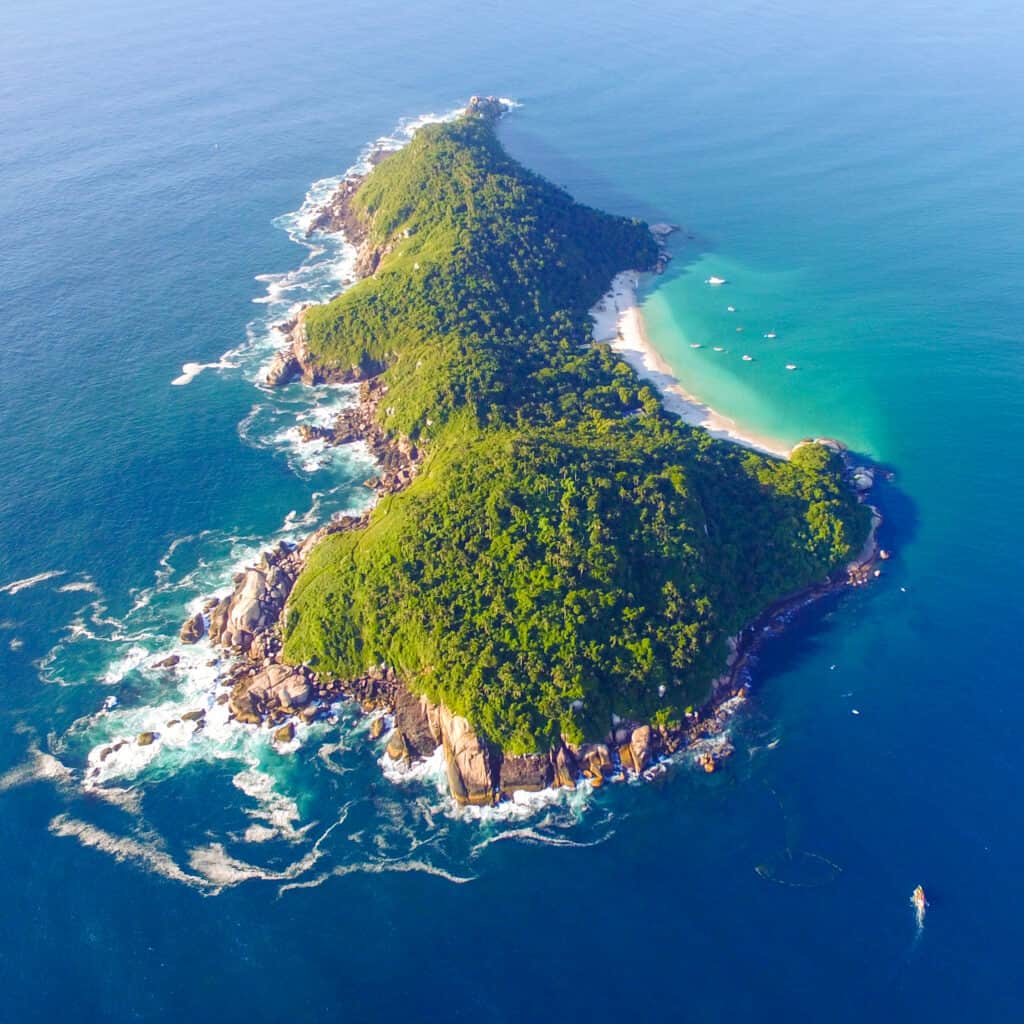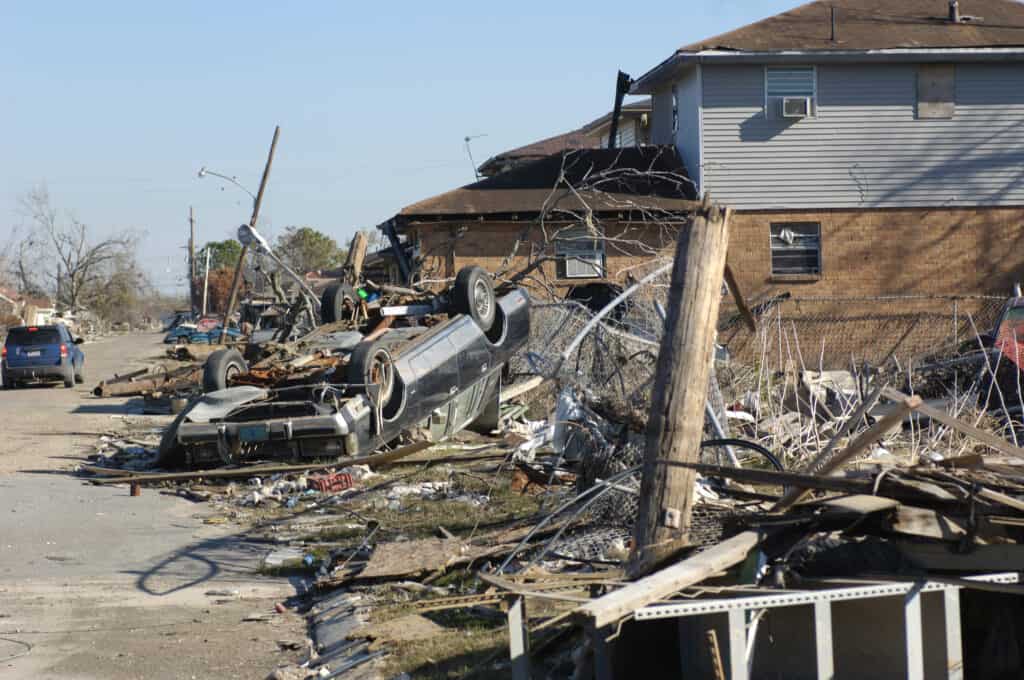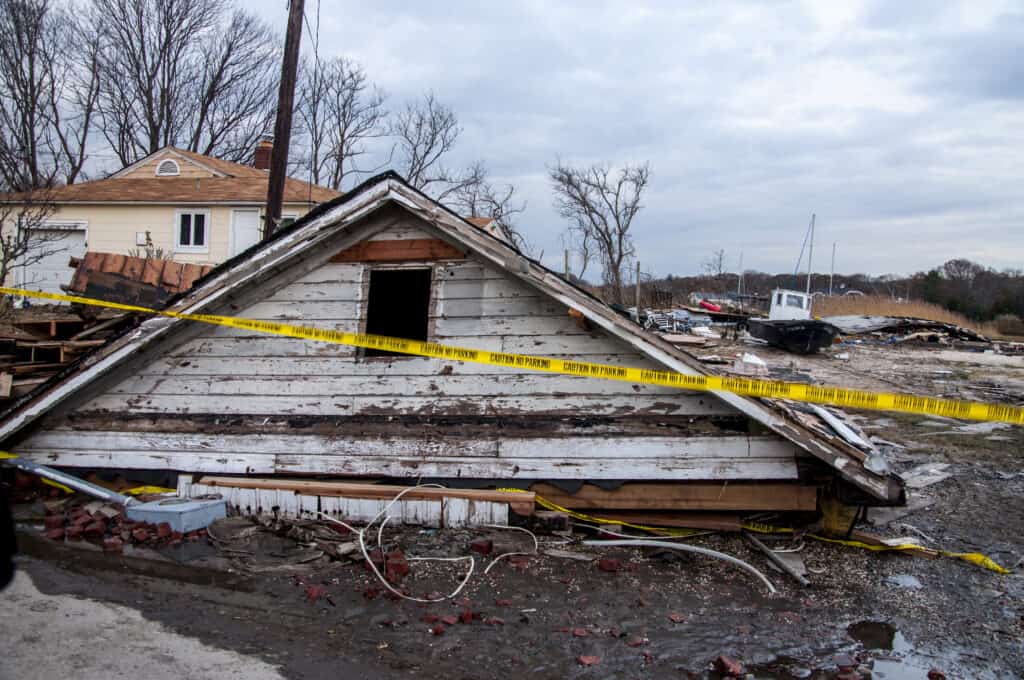We’ll examine the top 5 hurricanes to hit the US during the past 25 years (1995 to 2020) in today’s post. Below, we’ll concentrate on hurricane-related deaths as well as damage in terms of money and area. These hurricanes are all at least category 3 status. It’s vital to remember that all storm types can produce deadly winds. However, hurricanes that are categorized as Category 3 or above are often stronger. Let’s get going!
1. Hurricane Mitch – 1998

Hurricane Mitch left Honduras on October 29 and continued through Central America, reforming in the Bay of Campeche, before making landfall in Florida.
©Gustava Testa/Shutterstock.com
Category 5
Hurricane Mitch was not only the deadliest hurricane in the Atlantic in 1998, but it was also the second-worst hurricane in the Atlantic in history after the Great Hurricane of 1780. After drifting across Central America and renewing in the Bay of Campeche, Mitch eventually made landfall in Florida as a strong tropical storm. It was given the strongest hurricane classification possible, Category 5. A fishing boat capsized in the Florida Keys, killing two people. However, Honduras, which accounted for more than half of all fatalities, experienced the most disastrous impacts. Severe flooding was the main cause of most of the fatalities.
Mitch wreaked considerable property, infrastructure, and agricultural damage in Central America, as well as $40 million worth of damage in Florida. More than 11,000 people remained missing as of the end of 1998, and at least 11,374 deaths had been reported; the precise death toll may never be known. In addition, Mitch’s hurricane caused about 2.7 million people to lose their homes. The estimated cost of the hurricane’s overall losses was $6 billion.
2. Hurricane Katrina – 2005

In 2005, Hurricane Katrina decimated and devastated so much of New Orleans. The city’s Ninth Ward was hit particularly hard.
©Marc Pagani Photography/Shutterstock.com
Category 5
The 2005 Atlantic hurricane season set a new record for activity before it was surpassed in 2020. More than 1,800 people died as a result of Hurricane Katrina, a very dangerous Category 5 Atlantic hurricane that hit in late August 2005. Damage was $125 billion, with most of it occurring in and around New Orleans. Upon entering the Gulf of Mexico on August 26, Katrina briefly decreased in strength over southern Florida to a tropical storm. She rapidly became more serious after that. The storm strengthened into a Category 5 hurricane as it moved across the warm waters of the Gulf of Mexico. During its second landfall across Mississippi and southeast Louisiana on August 29, 2005, it was downgraded to Category 3.
The majority of fatalities were caused by flooding, which was primarily due to levee system engineering flaws that prevented New Orleans from being flooded. The majority of New Orleans’ transportation and communication infrastructure was also severely damaged by the floods. As a result, tens of thousands of city dwellers who had been imprisoned inside the city went without access to food, shelter, or other necessities.
3. Hurricane Ike – 2008

Photo taken amid sea spray and crashing waves as Hurricane Ike’s outer bands impact the Florida coast, September 2008.
©forestpath/Shutterstock.com
Category 4
The Atlantic hurricane season of 2008 was the deadliest since 2005. It resulted in over 1,000 fatalities and $50 billion in damage. Hurricane Ike wreaked the most havoc in the US in 2008. This is despite Hurricane Hanna being a devastating and powerful tropical cyclone that wreaked major damage over the Western Atlantic. In September 2008, Hurricane Ike, a powerful tropical cyclone, passed through areas of the Greater Antilles and North America, decimating infrastructure and agriculture, particularly in Texas and Cuba. Ike has been responsible for at least 192 fatalities. Haiti, which was still fighting to recover from the effects of the three storms that devastated the nation that year—Fay, Hanna, and Gustav—saw 74 of these fatalities.
According to estimates, Ike’s destruction cost the coastal and interior parts of the United States $30 billion (2008 USD), Cuba $7.3 billion, Turks & Caicos $500 million, and the Bahamas $200 million, for a total of at least $38 billion in losses. Seven people passed away in Cuba. As of August 2011, 16 people were still unaccounted for, while 113 people had previously been confirmed dead in the US.
4. Hurricane Sandy – 2012

Hurricane Sandy became the largest Atlantic hurricane on record, with a top speed of up to 115mph.
©Cathy Kovarik/Shutterstock.com
Category 3
Superstorm Sandy, commonly referred to as Hurricane Sandy, was a particularly strong and destructive Atlantic hurricane. Its gusts could be felt 1,150 miles away. In terms of circumference, it was also the biggest Atlantic storm ever observed. From the Caribbean to Canada, the hurricane killed 233 people. It left behind almost $70 billion in damages in eight different countries (2012 USD).
On October 22, Sandy began as a tropical wave in the western part of the Caribbean Sea. Six hours later, it became Tropical Storm Sandy. Sandy, which had intensified into a hurricane by October 24, hit land close to Kingston, Jamaica. Sandy made landfall in Cuba on October 25 as a Category 3 hurricane before downgrading to a Category 1 hurricane. On October 26, Sandy passed through the Bahamas in the morning. Sandy briefly became a tropical storm on October 27 before gaining enough intensity to become a Category 1 hurricane.
Early on October 29, Sandy curved west-northwest before making landfall as a post-tropical cyclone with hurricane-force winds near Brigantine, New Jersey. Sandy continued to weaken and move ashore for a few more days. It was then absorbed by an incoming extratropical storm in November. The entire eastern shore of the United States, including Florida, Maine, the Appalachians, Michigan, and Wisconsin, was affected by Hurricane Sandy. New York and New Jersey sustained the most substantial damage. On October 29, its storm surge hit New York City. While there, it flooded the city’s streets, tunnels, and subway lines. It also cut off electricity to the whole region. A $65 billion loss was incurred by the United States (2012 USD).
5. Hurricane Harvey – 2017

Hurricane Harvey caused flooding and lost power in much of Houston.
©AMFPhotography/Shutterstock.com
Category 4
In 2017, Category 4 Hurricane Harvey made landfall on San Jose Island in Texas with gusts of 130 mph. A few short hours later, Texas was hit by Harvey. In the state, it is estimated that 300,000 buildings and 500,000 cars were destroyed or damaged. The Houston metro area received about 30 inches of rain over the course of three days when the hurricane intensified into a tropical storm and stalled over Texas.
Harvey first made landfall in Louisiana, then made his way back to the Gulf of Mexico before heading northeast as a tropical depression. It caused further flooding along the way. Flooding, building damage, auto damage, property loss, and other connected disasters are estimated to have cost a total of $125 billion. Over 100 deaths that were reportedly due to the storm were documented.
In Conclusion

You can see how severity can drastically change the amount of damage done by a hurricane.
©Michael Grachikov/Shutterstock.com
Out of the hundreds of hurricanes that have battered the United States over the past few decades, it is tough to select the top five. When trying to answer this kind of issue, there are a lot of different factors that can be considered. Although many hurricanes and tropical storms throughout this time period caused destruction and had long-lasting effects in their wake, only these five storms happened to be category 3 or above. It appears that when it comes to the “biggest,” the hurricanes that caused the most amount of damage were undoubtedly those with winds higher on the Saffir-Simpson Hurricane Wind Scale. This scale is used to estimate the potential property damage a storm would cause due to wind. Other deadly threats include storm surges, downpours, and tornadoes.
All types of storms have the potential to produce deadly tornadoes, flash flooding, and winds. However, it seems true that high-category hurricanes have the potential to cause catastrophic wind damage and significant human casualties simply because of the strength of their winds. Major hurricanes are those with a category rating of 3 or higher because they can cause severe property damage and loss of life. Rapid intensification occurs in about 80% of big hurricanes. Since 1980, 170 landfalling tropical cyclones in the Atlantic have rapidly intensified. Nearly 73% of the 56 tropical cyclones that cost the United States at least $1 billion in damage between 1980 and 2021 exhibited fast intensification.
Summary of the Biggest Hurricanes in the United States between 1995 and 2020.
| Name of Hurricane | Year | Category | Cost of Damage |
|---|---|---|---|
| Mitch | 1998 | 5 | $6B |
| Katrina | 2005 | 5 | $125B |
| Ike | 2008 | 4 | $30B |
| Sandy | 2012 | 3 | $70B in eight countries; $65B in US |
| Harvey | 2017 | 4 | $125B |
The photo featured at the top of this post is © aappp/Shutterstock.com
Sources
- Climate Central, Available here: https://www.climatecentral.org/climate-matters/hurricane-intensity-and-impacts
- Loop, Available here: https://caribbean.loopnews.com/content/five-most-destructive-hurricanes-last-decade
- Wikipedia, Available here: https://en.wikipedia.org/wiki/List_of_Atlantic_hurricane_records#:~:text=Worldwide%20cyclone%20records%20set%20by%20Atlantic%20storms%20%5B,%E2%80%93%2098%20feet%20%2830%20m%29%20%5B82%5D%20More%20items
Thank you for reading! Have some feedback for us? Contact the AZ Animals editorial team.






